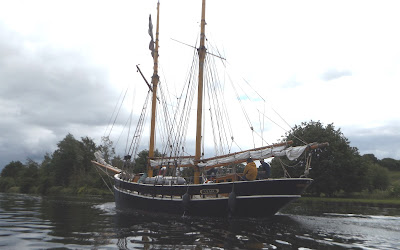We stopped at Purton on Tuesday, mooring not far past the two Purton Swing Bridges. The expected showers didn't materialise, although it did remain overcast until later in the evening.
Purton Lower Swing Bridge.
The bridges are close together and are controlled from this one.
In 1909 a large slip on the river bank here at Purton threatened the G&S canal. With no locks on it's 16 mile length a breach would have been disastrous. The canal runs very close to the river at this point, and something had to be done!
The Chief Engineers solution was simple and cost effective. He called for redundant barges and other vessels to be towed to Sharpness, dropped down onto the river at high tide and then beached on the vulnerable bank with the hulls breached. The plan was that the hulks would form the basis for sandbanks to build up and reinforce the bank.
Between 1909 in 1965, 85 craft were repurposed as bank protection, most of the earlier ones have been swallowed by the sand and silt they attracted, but the remains of several of the later ones are still visible.
Envoy, one of the first sacrifices...
Most of the remains have been identified and have these memorial plates alongside.
The ferrocement barges, built during WWII when there was a shortage of steel and timber, have fared the best.
From the point at the end of the old tidal basin... Upstream...
...and downstream.
The buildings centre of picture are either Berkeley or Oldbury Nuclear Power Stations, now in the process of dismantling.
To the right can be seen the cable support towers of the Severn Road Bridge, the suspension bridge opened in 1966 and 10 miles downstream. The newer Prince of Wales is out of sight, another 3 miles away.
Talking about Berkeley, when the Act of Parliament for the construction of the Gloucester and Sharpness Canal was applied for, in 1793, it was for the Gloucester and Berkeley Canal, as the original intention was for it to reach the Severn just over 2 miles further downstream. Some old maps still show it as the Gloucester and Berkeley Canal, although running to Sharpness.
Financial difficulties kept delaying the project, but at the time it was opened in 1827 it had cost twice the original estimate of £200,000 to finish.
At the time it was the broadest and deepest canal in the world, able to take vessels over 200 feet long and 30 feet wide.
On the subject of large craft, it wasn't planned but our visit coincides with the Gloucester Tall Ships Festival. After seeing La Malouine the other day, there have been several others heading up to Gloucester. Sorry about the quality of some of the photos...
TS Vilma, topsail schooner, built 1934.
Vilma - Anglesey Traditional Sail
TS Anny of Charlestown, another topsail schooner, from 1930.
Anny of Charlestown - Classic Sailing (classic-sailing.com)

Last but not least, TS Irene, a ketch built in 1903 and a movie star, having appeared in Pirates of the Caribbean!





















1 comment:
Great photos Geoff and the tall ships are an amazing sight. Looks like you're having a great cruise. x
Post a Comment